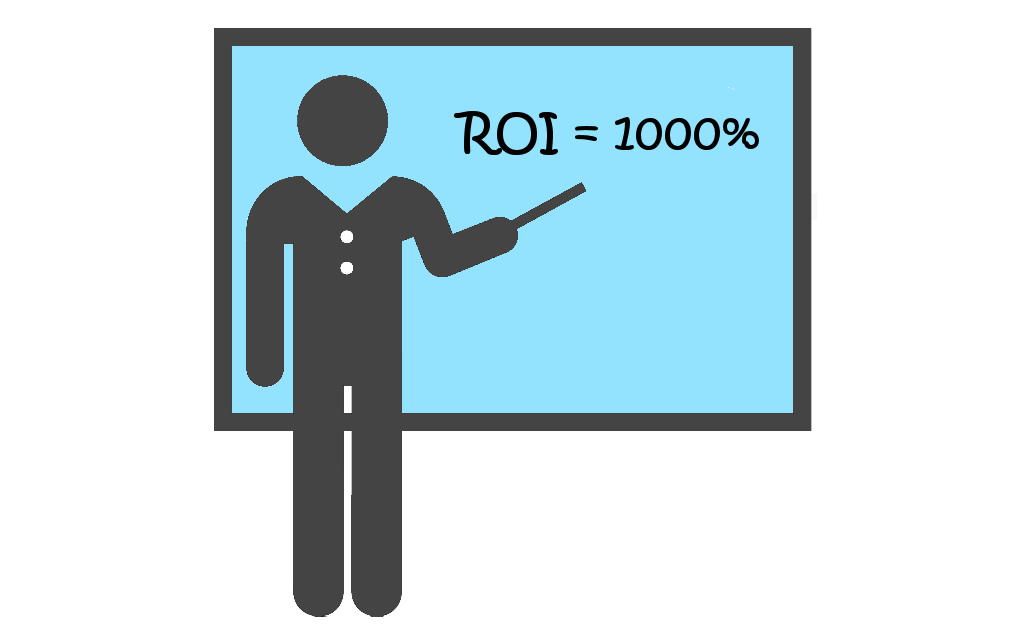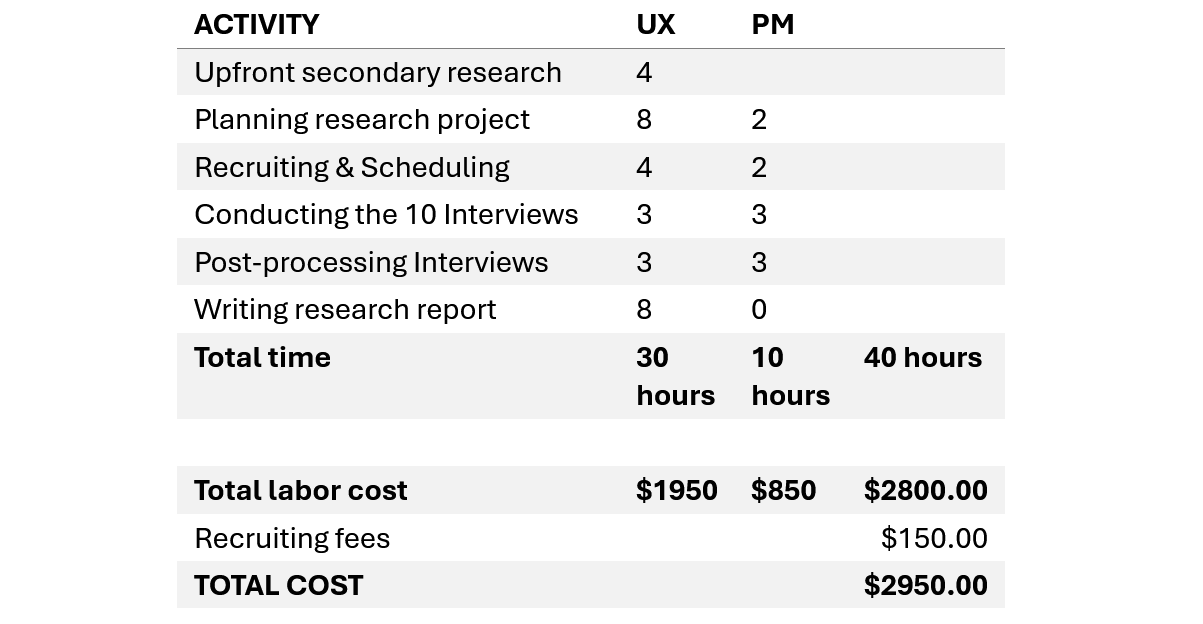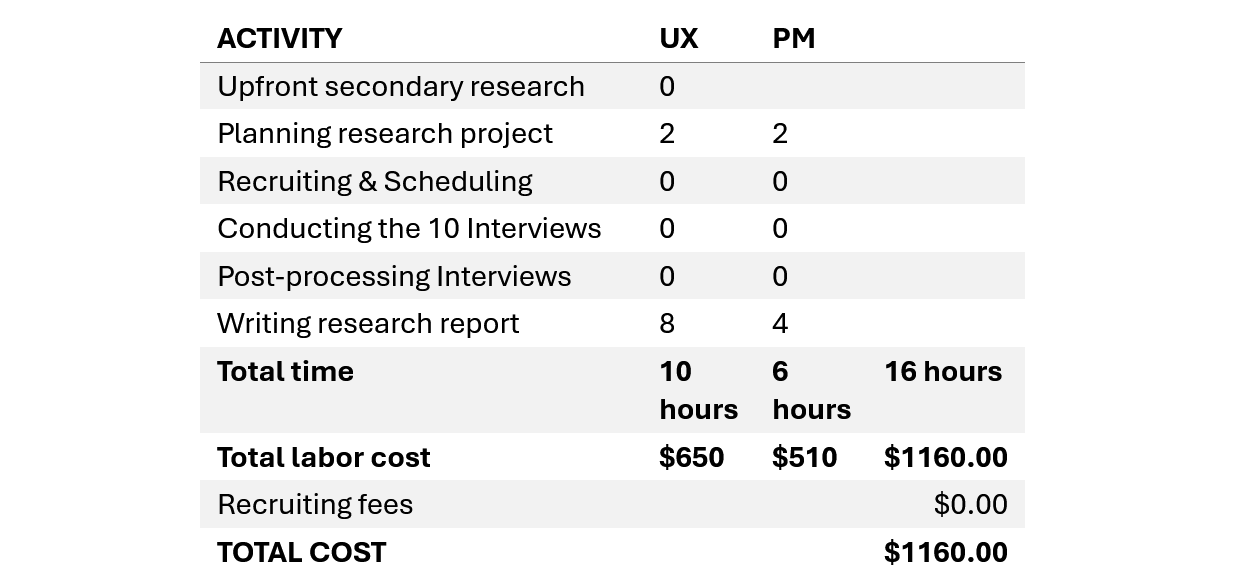
ROI of AI-powered User Research
Management Summary
Many product teams struggle to do user research early enough. Without early research, teams don’t really understand what users need or how they work, and consequently designs are based on opinions instead of facts.
The Product Context Analyzer (PCA) uses AI to help teams continuously understand user needs and create user requirements without waiting weeks for interviews or needing a research budget.
PCA isn’t just cheaper – it has a high direct return of investment (ROI = ~1000%) on your user research operations and transforms how product teams work by
- enabling ongoing, scalable, and automated user research.
- reducing reliance on interviews and workshops.
- providing richer, more comprehensive user insights than traditional methods.
Standardize your user research operations on PCA to solve your user research bottleneck and empower anyone on the team to understand user context without needing to be an expert researcher.
Benefits of Product Context Analyzer
The Product Context Analyzer is an always-available online service that delivers deep insight into the context of use for a product and generates user requirements for a specific use case that is scheduled to be built.
Because of the significant time span from request to delivery, many product teams cannot afford thorough user research unless this is planned and funded at a very early stage in the development process. Consequently, the design and solution validation are often performed without a clear understanding of the actual user needs and task flows. Furthermore, the absence of written user requirements invites everyone to judge design based on personal opinions instead of evaluating a design against identified requirements or agreed UX quality objectives.
Leveraging an AI-powered tool like the Product Context Analyzer, any product team can produce user requirements on time. Instead of conducting a one-off research project prior to development, the Product Context Analyzer delivers this information instantly on demand whenever design input is needed which results in a culture of continuous learning about user requirements.
Quantitative Benefits of Product Context Analyzer
To estimate the monetary benefit of using the Product Context Analyzer, we have modeled the current research practice as the baseline scenario and then created two different scenarios of using the Product Context Analyzer either to fully replace traditional user research or to augment primary research with automated secondary research.
As the baseline, we define a traditional approach of interviewing 10 users in the field without any tool support. To compare this baseline against the use of the Product Context Analyzer, we estimated the cost and time for each of the scenarios (see table 1).

(see appendix for details)
As depicted in table 1, using PCA dramatically reduces both costs and project time. The very high gain of 96.8% in project time of using PCA versus traditional primary research illustrates the disruptive nature of using the Product Context Analyzer: What usually takes weeks if not months, can be achieved within hours. This speed transforms the user research into an on-demand generation of user requirements to inform design decisions anytime throughout the product development process.
To calculate the Return of Investment (ROI), we take the price of an annual subscription $480 as the investment and calculate the ROI as (Amount Gained – Amount Spent) ÷ Amount Spent x 100.

(see appendix for details)
As depicted in table 2, when purchasing an annual subscription of Product Context Analyzer you get between 8x to 12x return of your spend in form of reduced operational costs, which is considered an excellent return on your investment.
Qualitative Benefits of Product Context Analyzer
Besides comparing the quantitative cost savings for research projects, the deployment of Product Context Analyzer has other positive implications:
Scalable UX Operations
- 100% coverage of all product teams with professional information about context of use Less pressure on upfront research to deliver any possible details, because additional analysis with different focus and scope can be done any time later
- More compact interview schedules because of automated post-processing of interview
Improved Requirements Management
- Explicit documentation of detailed user requirements linked to the context analysis Explicit documentation of desired outcomes linked to the context analysis
- Accelerated and consistent writing of user stories linked to the context analysis
Catalyst for Product Innovation
- Strict separation of problem space and solution space avoids premature solutioning
- Jobs-to-be-done outcome analysis helps to focus on the underserved outcomes
- Decisions-to-be-made help to identify potential for artificial intelligence
The indirect effect of these qualitative benefits has not even been considered in our ROI calculation. Forresteris estimating the overall ROI of UX as high as 9900%, which means 1 dollar spent on UX produces a value of $100 by reducing development and delivering better user experience. This means that standardizing all product teams, including those who typically remain unsupported due to the lack of strategic relevance on using Product Context Analyzer to model their context of use, will easily pay off the investment.
Conclusion
Product Context Analyzer is not only a tool that radically reduces operational costs and time of user research, but it enables all product teams to live an integrated user-centric design and development process. The Product Context Analyzer scales and democratizes user research by generating professional requirements models and user story statements that normally require highly skilled user researchers and business analysts.
Using the world-knowledge of LLM systems, Product Context Analyzer enables product teams to perform a fully automated discovery and create a context of use specification without any dependency on travel budget, availability of domain experts, or access to end users. This reduces, if not eliminates the need for traditional labor-intensive primary research such as interviewing end users, tagging transcripts, synthesizing qualitative data into coherent reports, or formulating requirements statements. Using LLM as the data source for discovery, the Product Context Analyzer produces a much more detailed and representative context of use description than you can get from a handful of stakeholder interviews.
The ease of running an automated discovery helps user research to scale and become an always available service throughout the product development life cycle. Instead of organizing expensive workshops in which domain experts and customers are brainstorming who their users are and what they are doing, the focus can be on validating the identified key issues and UX objective with a small sample of customers. Once you narrow down on a solution, use Product Context Analyzer again to analyze specific user roles and tasks which are relevant for the scope of your design solution, to get detailed task flows and desired outcome specific to the use case you are interested in.
Considering the excellent ROI of ~1000%, do not hesitate and take the leap and empower your UX organization and product management with an AI-first service that delivers unparalleled value for less. Establish a user-first mindset in your product organization which is empowered by continuous learning about users and their needs, and operating on explicit user requirement statements with help of AI.
Appendix:
Scenario-based Estimate of the Benefits of Product Context Analyzer
Description of Scenarios
To compare the Return of Investment (ROI) and Return of Time (ROT) of using the Product Context Analyzer, we defined a traditional user research project with 10 interviews as the baseline. The cost and time of this baseline scenario are then compared with the scenario of using the Product Context Analyzer in combination with reduced primary research (augment) or completely eliminating primary user research with the output of the Product Context Analyzer (replace):
TRADITIONAL - 10 on-site context interviews:
- The product manager contacts customers to get access to their employees for the purpose of conducting workplace interviews. The user researcher follows up with scheduling all interviews at three different customer sites. Once everything is confirmed travel is planned for the user research plus a product manager to interview each user at their workplace for 1 hour. Each interview must be transcribed and consolidated in findings. After all interviews are complete, the findings must be consolidated into one report.
AUGMENT - Product Context Analyzer plus 3 hybrid interviews:
- The user researcher uses the Product Context Analyzer to prepare for primary research by generating detailed requirements models for relevant stakeholders and tasks with minimal effort. Based on this foundational knowledge, the user researcher organizes three remote interviews with end users or subject matter experts to validate the output and potentially learn about additional information which was not discovered when using Product Context Analyzer.
REPLACE - Product Context Analyzer only:
- The user researcher teaches the product manager how to use the Product Context Analyzer. The product manager then runs the analysis with use cases they aim to support and gets back detailed requirements models for relevant stakeholders and tasks related to those use cases. All results can be shared with the team and the product manager can go back anytime to run additional analysis when additional information is needed.
Assumptions about Costs and Time
To establish an estimate of the labor costs of traditional user interviews we have adapted the information about labor costs published by userinterviews.com (see table 3).

source: https://www.userinterviews.com/ux-research-roi-cost-savings-report-2023
Those hourly rates are rather conservative estimates and may vary based on region, organization, and role.
Table 4 estimates the overall project time needed to plan and conduct traditional user interviews. This estimate is based on our own consulting and work experience in the industry.

Note: We estimated the overall time as rather long because of the complexity of finding customers and scheduling the interviews and debriefing sessions.
Estimates for Traditional Scenario (baseline)
Table 5 lists the estimates for the baseline scenario where the user researcher is conducting 10 in-person field interviews with support from product management.

Labor Time for UX and Product Management (PM) for a 10 Interview project (this may vary depending on the accessibility to customers and interviewees)
This estimate does only consider core activities performed by UX and PM. It does not include travel and the actual labor costs are likely to be higher when also considering other stakeholders involved, e.g.: the account manager of the client, the point of contact at the customer side, the interviewees, and other product managers or consultants joining the user researcher on the site visit.
Estimates for Augment Scenario
This scenario assumes that the Product Context Analyzer is used for upfront secondary research and then speeds up primary research by giving the team a warm start with detailed requirement models that reduce the number of interviews compared to starting from scratch (see table 6).

Labor Time for UX and Product
Management (PM) for a hybrid project which reduces number of interviews to three for just validating Product Context Analyzer output
Estimates for Replace Scenario
The third scenario assumes that the Product Context Analyzer is used as the only source for user requirements and replaces secondary and primary research, and that the product manager will be trained by the user researcher in how to run the analysis on her own (see table 7). Once the product manager has generated the requirements for relevant use cases, the user researcher helps to consolidate the output of the Product Context Analyzer into a user research report.

Labor Time for UX and Product
Management (PM) for only using Product Context Analyzer